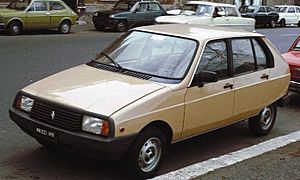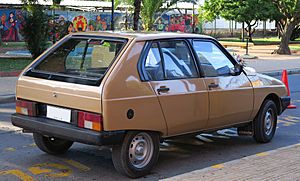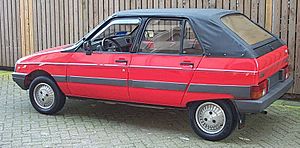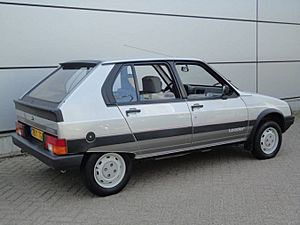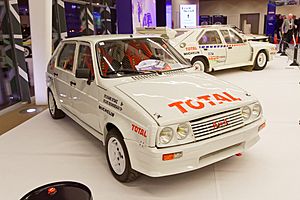Citroën Visa facts for kids
Quick facts for kids Citroën Visa |
|
|---|---|
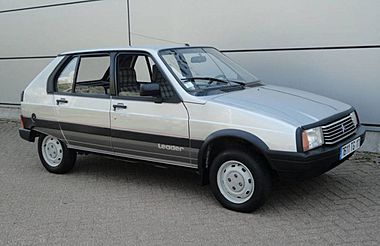 |
|
| Overview | |
| Manufacturer | Citroën |
| Also called | Wuling LZW 7100/ Wuling Visa (PRC) |
| Production | 1978–1988 1991–1994 (China) |
| Assembly | France: Rennes (PSA Rennes Plant) Spain: Vigo (PSA Vigo Plant) Portugal : Mangualde (PSA Mangualde Plant) Belgium: Forest Yugoslavia: Koper (Cimos) |
| Body and chassis | |
| Class | Supermini (B) |
| Body style | 5-door hatchback 4-door cabriolet |
| Layout | FF layout F4 layout |
| Related | Citroën C15 Karenjy Visa (RM) Citroën Axel / Oltcit Club |
| Powertrain | |
| Engine | |
| Dimensions | |
| Wheelbase | 2,436 mm (95.9 in) |
| Length | 3,690 mm (145.3 in) |
| Width | 1,530 mm (60.2 in) |
| Height | 1,410 mm (55.5 in) |
| Weight | 870 kg (1,918 lb) |
| Chronology | |
| Predecessor | Citroën Ami Citroën Dyane |
| Successor | Citroën AX |
The Citroën Visa was a small, five-door car made by Citroën from 1978 to 1988. It was a supermini, meaning it was a compact car, and came with both gasoline and diesel engines. Over 1.25 million of these cars were built.
The Visa was updated once in 1981. China also made a version of the car called the Wuling LZW 7100 from 1991 to 1994. Citroën also created a convertible version called the Décapotable in 1984. A van version, the Citroën C15, was sold from 1985 to 2005.
Contents
How the Citroën Visa Was Developed
In the 1960s, Citroën started working on a new small car to replace the popular Citroën 2CV. This project was called the G-mini and later EN101. The goal was to create a car that was small on the outside but roomy inside. However, these early ideas were not fully developed because people who saw them didn't like them.
Later, in the early 1970s, Citroën worked with Fiat on a project called "Prototype Y." This project aimed to replace the Citroën Ami. It used parts from the Fiat 127, which had a clever design where the engine was placed sideways at the front.
When Citroën and Fiat stopped working together, Citroën designed its own car platform. After Peugeot took over Citroën in 1974, the project was renamed "Projet VD." This became the Citroën Visa. It used the base of the Peugeot 104 car, including its engine, gearbox, and chassis. This made the Visa the first car to share parts between Peugeot and Citroën.
In 1984, the original design from "Project Y" was used to create the Romanian Oltcit Club. This car used a Citroën Visa engine. It was also sold in Western Europe as the Citroën Axel.
Citroën Visa: Design and Features
The Citroën Visa was launched in September 1978. It was a front-wheel drive car. Early models included the "Spécial" and "Club" with a small 2-cylinder engine. The "Super E" model had a more advanced 4-cylinder engine from Peugeot. This engine was very fuel-efficient and performed much better than the smaller one.
The Visa had a soft but stable suspension system. This made the ride smooth, similar to the Citroën 2CV. In 1983, the Visa Super E GL offered more features and a comfortable two-part rear seat. These seats could be easily removed to create more space for luggage.
Also in 1983, the powerful Visa GT was introduced. It had a stronger engine, special wheels, spoilers, and a sportier suspension. In 1985, a limited edition called the Visa 14 S Tonic was released. It looked similar to a racing car but was more affordable.
In 1984, a diesel version was added. The Visa 17D and 17RD used a strong 1.7-liter diesel engine from the Peugeot 205. This engine was so big that the front of the car had to be made wider with black plastic panels. The spare wheel, which was usually under the hood in petrol versions, was moved to the boot.
The Visa 14 TRS was introduced in 1984 for the 1985 model year. It shared its engine with the Citroën BX14. In early 1985, the Visa GTI was launched. It had a 1.6-liter engine, making it the fastest Visa model.
Production of the Visa ended in late 1988. It was replaced by the five-door version of the Citroën AX.
Dashboard and Interior Features
The Visa had unique controls on the dashboard. They were located in two pods next to the steering wheel. These controls were called PRN Lunule (Satellites). They allowed the driver to easily reach controls for wipers, horn, lights, and heating.
In March 1981, the Visa got a new look, but it kept its special interior controls. This updated model was called the Visa II. In 1984, the Visa was updated again with a new dashboard and instruments. It also got self-cancelling turn signals, a first for Citroën.
The car's curved windscreen allowed for a very large single wiper. The front design also helped keep dirt off the headlights and protected them from stone chips. The heating system could blow cool air to your face while warming the rest of the car.
The Visa's rear parcel shelf was clever. It had two parts, one in the car and one on the tailgate. This allowed taller items to fit without removing the whole shelf.
Visa Décapotable: The Convertible Version
In 1984, Citroën asked a company called Heuliez to create a four-door convertible version of the Visa. This car was called the Visa Décapotable. It was a special type of convertible where the doors and window frames stayed in place.
The convertible was heavier and slower than the regular hatchback. It also cost about 50 percent more.
Citroën Visa Engines
The Citroën Visa offered a variety of engines throughout its production. These included small 2-cylinder engines and larger 4-cylinder engines, both petrol and diesel.
| Engine Code | Engine Type | Cubic Capacity (cc) | Maximum Power | Maximum Torque |
|---|---|---|---|---|
| V06/630, V06/644, V06/665 | 2 cylinders (Boxer) | 652 | 34.5 PS (25 kW; 34 hp) at 5250 rpm | 48 N⋅m (35 lb⋅ft) at 3500 rpm |
| XV8 | 4 cylinders | 954 | 45 PS (33 kW; 44 hp) at 6000 rpm | 65 N⋅m (48 lb⋅ft) at 2750 rpm |
| XW7 | 1124 | 50 PS (37 kW; 49 hp) at 5500 rpm | 83 N⋅m (61 lb⋅ft) at 2500 rpm | |
| XZ5X | 1219 | 64 PS (47 kW; 63 hp) at 6000 rpm | 91 N⋅m (67 lb⋅ft) at 3000 rpm | |
| XY7 | 1360 | 60 PS (44 kW; 59 hp) at 5000 rpm | 105 N⋅m (77 lb⋅ft) at 2500 rpm | |
| XY8 | 80 PS (59 kW; 79 hp) at 5800 rpm | 108 N⋅m (80 lb⋅ft) at 2800 rpm | ||
| XU5J | 1580 | 115 PS (85 kW; 113 hp) at 6250 rpm | 131 N⋅m (97 lb⋅ft) at 4000 rpm | |
| XUD7 | 4 cylinders diesel | 1769 | 60 PS (44 kW; 59 hp) at 4600 rpm | 112 N⋅m (83 lb⋅ft) at 2000 rpm |
This table shows the different models, their engines, and how they performed:
| Model
|
Engine | Displacement cc |
Fuelling | Power/rpm | Torque/rpm | Drive | Standard Number Manual Gears |
Kerb Weight | Speed max |
Acceler. 0–100 km/h (0-62 mph) (seconds) |
Consum. (l/100 km) |
Production years |
Cooling |
|---|---|---|---|---|---|---|---|---|---|---|---|---|---|
| Petrol Versions | |||||||||||||
| Visa Special/Club/ Entreprise/base |
V06 | 652 | Carburetor | 34.5 PS (25 kW; 34 hp)/5250 | 49 N⋅m (36 lbf⋅ft)/3500 | FWD | M/4 | 745 kg (1,642 lb) | 128 km/h (80 mph) | 29.3 | 5.4 | 1978-87 | Air |
| Visa 10E | XV | 954 | 45 PS (33 kW; 44 hp)/6000 | 66 N⋅m (49 lbf⋅ft)/3000 | 810 kg (1,786 lb) | 133 km/h (83 mph) | 19.8 | 6.6 | 1986-881 | Water | |||
| Visa Super/Super E/ L / 11 E/11 RE/Entreprise |
XW7 | 1124 | 50 PS (37 kW; 49 hp)/5500 | 84 N⋅m (62 lbf⋅ft)/2500 | 800 kg (1,764 lb) | 144 km/h (89 mph) | 16.6 | 7.7 | 1978-88 | ||||
| Visa Cabriolet | 813 kg (1,792 lb) | 137 km/h (85 mph) | 20.7 | 6.5 | 1983-85 | ||||||||
| Visa Super X | XZ7G | 1219 | 64 PS (47 kW; 63 hp)/6000 | 91 N⋅m (67 lbf⋅ft)/3000 | 815 kg (1,797 lb) | 155 km/h (96 mph) | 14.0 | 8.3 | 1980-82 | ||||
| Visa 14 TRS | XY7 | 1360 | 60 PS (44 kW; 59 hp)/5000 | 105 N⋅m (77 lbf⋅ft)/2500 | 830 kg (1,830 lb) | 153 km/h (95 mph) | 14.0 | 6.3 | 1985-87 | ||||
| Visa GT/Chrono2/Tonic | XY8 | 80 PS (59 kW; 79 hp)/58003 | 109 N⋅m (80 lbf⋅ft)/2800 | M/5 | 830 kg (1,830 lb) | 168 km/h (104 mph) | 10.9 | 7.3 | 1982-85 | ||||
| Visa Chrono4 | XYR | 93 PS (68 kW; 92 hp)/5800 | 125 N⋅m (92 lbf⋅ft)/4500 | 850 kg (1,874 lb) | 173 km/h (107 mph) | 10.2 | 8.5 | 1982 | |||||
| Visa 1000 Pistes | - | 112 PS (82 kW; 110 hp)/6800 | 131 N⋅m (97 lbf⋅ft)/4500 | AWD | 183 km/h (114 mph) | 8.7 | 9 | 1983 | |||||
| Visa GTi | XU5J | 1580 | Electronic Multi Port Injection |
105 PS (77 kW; 104 hp)/6250 | 134 N⋅m (99 lbf⋅ft)/4000 | FWD | M/5 | 870 kg (1,918 lb) | 188 km/h (117 mph) | 9.1 | 7.4 | 1985-86 | |
| XU5 JA/K | 115 PS (85 kW; 113 hp)/6250 | 192 km/h (119 mph) | 8.8 | 7.8 | 1986-88 | ||||||||
| Diesel Versions | |||||||||||||
| Visa 17 D/17 RD/ 17 D Entreprise |
XUD7/K | 1769 | Naturally Aspirated Mechanical Indirect Injection |
60 PS (44 kW; 59 hp)/4600 | 110 N⋅m (81 lbf⋅ft)/2000 | FWD | M/4 | 890 kg (1,962 lb) | 152 km/h (94 mph) | 15.9 | 5.2 | 1984-88 | Water |
| Note: 1As early as 1984 in some markets 2It is understood the Chrono not solely intended to France and introduced in 1983 372 PS at 6000 rpm for the Swiss market 44 Designed exclusively for the French market |
|||||||||||||
Sporty Versions of the Visa
The first sporty version of the Visa was the GT, released in 1982. It had a 1.3-liter engine with two carburetors. In 1985, a special 'GT Tonic' version was made. It had a sportier look with wider wheel arches, similar to the 'Chrono' racing model.
The Visa Trophée was built in late 1981 for rally racing. It had a 1.2-liter engine that was specially modified to produce 100 horsepower. The Trophée was designed for private racing teams. It was made lighter by using fiberglass body panels and plastic side windows. This made it weigh less than 700 kg. Racing versions could be even more powerful, reaching up to 140 horsepower.
The Visa Chrono was released in 1982 for a different racing category. It used a 1.3-liter engine, similar to the GT, but with special carburetors that made 93 horsepower. The Chrono also had unique body stickers, fog lights, and a different dashboard. About 2,160 were made for France and 1,600 for other European countries.
The Visa "Mille Pistes" was a special four-wheel-drive version. Two hundred of these cars were built in 1984 for racing. The production version was like a four-wheel-drive Chrono. It had the same 1.3-liter engine but with different carburetors that made 112 horsepower. The "Mille Pistes" name came from a Visa 4x4 that won a rally race in 1983.
In 1984, the high-performance 1.6 GTi was introduced. The GTi used a 1.6-liter engine with fuel injection, borrowed from the successful Peugeot 205 GTI. Citroën added plastic wheel arch extensions and four round headlights to make the GTi look sportier. It was praised for its smooth ride and good handling. Even though it was cheaper than the Peugeot 205, its older looks meant it wasn't a huge seller.
See also
 In Spanish: Citroën Visa para niños
In Spanish: Citroën Visa para niños




